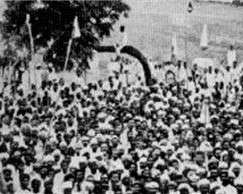
Mahatma Gandhi and Sardar Patel at Bardoli Protest
The recent farm bills by the Indian government sparked protests by the farmers due to different views over the benefits and drawbacks of the bills. These peaceful protests soon turned into brutal violence, created a large mess and rose a lot of debates in the nation. It was one of the most violent escalations of protests by farmers since the independence of India. But a former peaceful protest by farmers which emerged when India was under the rule of the British became a pivotal moment in the entire Indian Freedom Struggle. The non-violent farmers of Gujarat brought the British to their knees and set a perfect example of how an accurate and peaceful protest can make the change.
In February 1928, farmers from 137 villages from Surat, Gujarat challenged the British rule and played a huge part in restarting the freedom struggle. This incident also forged the path for the unforgettable Dandi Salt March, a movement guided by Mahatma Gandhi and Saradar Patel. The central reason behind the Bardoli Satyagraha was the Bombay Presidency Government's verdict to impose an unreasonable 30% rise in Inland revenue tariff. This verdict was held on the suggestions of a Provincial Civil Service officer who claimed that farmers were enjoying greater prosperity in the area following the establishment of the railway line in the Tapti river valley. They also believed that the condition of bonded and landless laborers had improved as well. Yet, the bureaucratic assessment of the ground situation was relatively different from reality.
Farmers tried to solve the issues with the government, but the demands of these farmers were ignored. With the resistance of government, farmers reached out to Sardar Patel, who had experiences of leading protests or Satyagrahas. After hearing the farmer's demands, Sardar Patel alerted them but similarly ensured that the Indian National Congress would support them if they decided to dive. He told them that if they fail miserably, they will not rise again for several years, but if they succeed, they will have committed much to lay the foundations of freedom. On 5 February 1928, the farmers were due to pay their first instalment of the increased tax, and Sardar Patel organized a meeting a day before. He told them, “A peasant does not need to be afraid of anything because he is a son of the soil who has worked with hard rocks, wild animals, heavy rain, biting cold, scorching heat and against so many odds”. The last date to pay the first instalment of tax was 15 February, and before that, Sardar Patel again held a meeting in Bardoli on 12 February where they decided not to follow the new regulations of the government.

The farmers demanded that the government either should appoint an independent tribunal to arrive at a fresh assessment or accept the previous amount farmers were supposed to pay. But when the government targeted the most vulnerable Bania money-lenders, some of them gave up and paid tax. However, Sardar Patel kept encouraging the farmers and the movement remained united. Even after four months, the farmers did not pay the revenue straight at the cost of attachment of their lands. They boycotted all the government officers, locked their houses for days together, and remained absent from their farms. The decision of government also affected Patidars, Anavil Brahmins, Muslims and Parsi landowners. Thus, the protests to challenge the administration received wide support from most of the sections of the society.
Numerous people joined this protest and stood by the farmers, they also remained noncooperative towards the government. Bardoli became a center of political activities during the Non-Corporation Movement with the Congress choosing Bardoli region to launch a passive resistance movement for no tax payment against the British government. Even after Mahatma Gandhi called off the Non-Cooperation Movement, Bardoli continued to observe the emergence of distinct revolutionary actions, and it became the center of protest in 1928. And the British government was feeling under pressure after numerous people joined the Bardoli protest. Even the media which was British-owned came out in support of the farmers, and the local Gujarati publications published every day about the farmers' protest. The media did a productive job of not just mobilizing apolitical sections of the crowd, but likewise offered ways to take an active part in the protests. And all of this supported the protest to become more beneficial and practical.

Later, a member from the Government's Council Chunnilal Mehta tried to do a settlement with the farmers. Mehta recommended a 5.7% increase and following payment of this tax, land that was confiscated by the government would be returned. Moreover, those who resigned from the government jobs to show their support for farmers protest would be reappointed. Due to the unity in public and protesters, the government was left with no option but to accept most of the recommendations by Mehta. However, the government refused to return the seized land under protest. But some wealthy people in Bombay came to support and bought the lands to return them to their original owners.
This protest was successful because the people who supported it were united and patient enough to achieve their goals and they were also successful to convince apolitical masses to stand against the British government. However, a hard-hitting fact is that these protests largely neglected the labor system and poor farmers. Even after being quite unfair, this single protest was a turning point in the freedom fight of India, because it was one of the initial protests which got successful without any violence. The farmers were satisfied after protest because they were assured that both parties can make a valid settlement, and it was one of the most crucial aspects that gave rise to a great victory.
______________________________________________
Reference:
- www.researchgate.net
- www.bardoli.gujaratonline.in
- www.wikipedia.org
